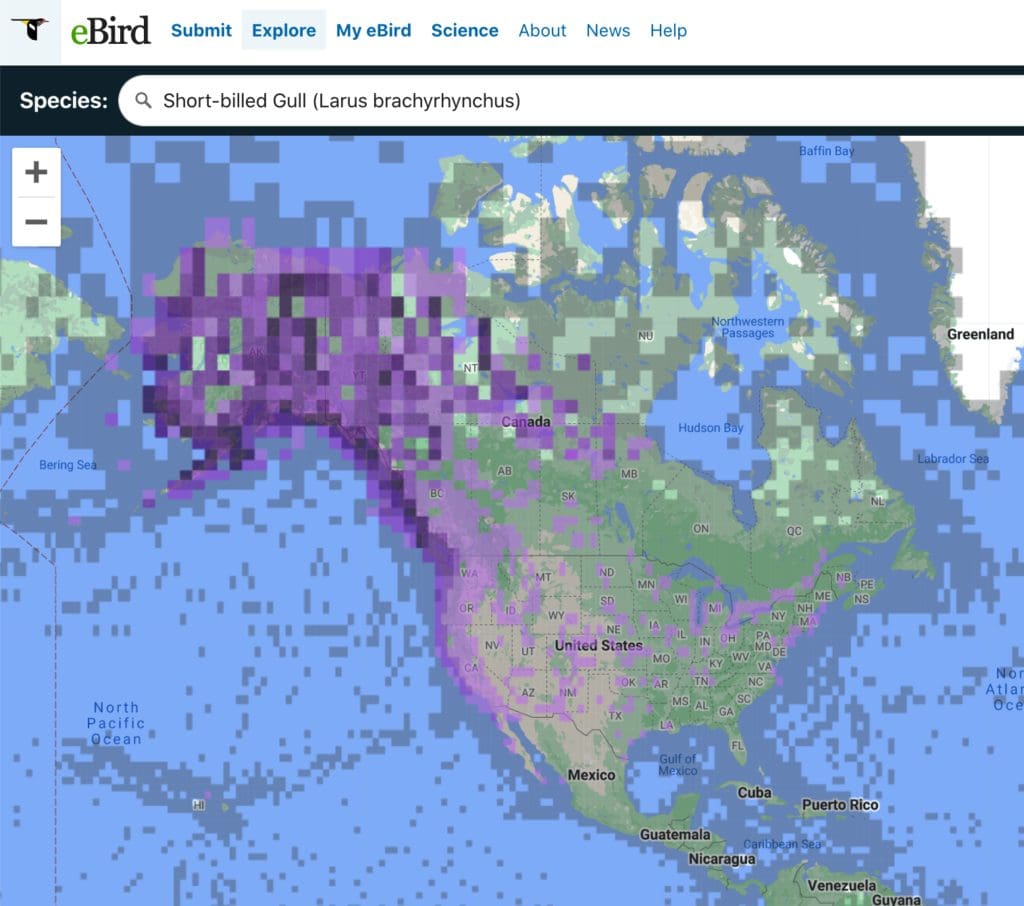Photo above: Short-billed Gull, March 20,2022. Long Beach, Stratford, CT. Photo for eBird by Frank Mantlik
Short-billed Gull (Larus brachyrhynchus)
During January 175 bird species were added to initialize this year’s eBird CT “state year list”. Four species were added in February, and in March EIGHTEEN additional new species were added to our state year list (bringing the state year list up to 197 species as of the end of March).
RARE BIRD SPECIES of the month:
The top three rare species were selected to be the following, in this proposed rank order of rarity, based mostly on the previous number of records in CT:
- Short-billed Gull. This is the 2nd CT record. Found by Aidan Kiley on March 20 at Long Beach, Stratford, CT.
- Slaty-backed Gull. This is the 3rd CT record. Found by Jeremy Nance on March 18 at Long Beach, Stratford, CT.
- Say’s Phoebe. This is the 4th CT record. Found by Tom Murray on March 19 at Sikorski Airport, Stratford, CT. Tom Murray also found the Lapwing in December!
This gull or complex of gulls (Mew Gull super-species, Short-billed Gull, Common Gull, along with the Common Gull’s three subspecies) has been the topic of debates for many years (e.g., see the image from the 1947 Peterson below). Now, with the help of the DNA-folks, these species relationships are getting clearer. If you only have time to read one of the references below, read the Sibley article. And if you really want all the details, read the two Dutch references below Sibley.
Note that the former “Mew Gull” complex has 4 taxa, currently treated as 2 species in the ABA:
MEW GULL COMPLEX – according to the ABA, as of April 2022:
- Short-billed Gull (monotypic) Larus brachyrhynchus.
- Common Gull, Larus canus, which consists of 3 subspecies
- nominate canus of Europe, Larus canus canus,
- subspecies heinei of Russia, Larus canus heinei,
- Kamchatka Gull, Larus canus kamtschatschensis, which breeds in far eastern Russia and is occasionally found as a very rare vagrant in the Northeast/Eastern Canadian provinces.
We had a Kamchatka Gull in CT last month, and now we have a Short-billed Gull! Not to mention the Slaty-backed Gull! Amazing. Many thanks to knowledgeable sharp-eyed, science-inspired birders in CT!
Below is Frank Mantlik’s eBird report with photos of this Short-billed Gull (https://ebird.org/checklist/S105250972 )
Flight shots show dark brown streaked head/neck, small thin greenish-yellow bill, and pattern of wing feathers. In general this species has less black toward the leading edge of the wingtip than Common Gull does, as well as more white in the tips of the primaries. The overall effect is of a fairly evenly forked V-shape of black around the wingtip, in contrast to the more solid black triangle of the Common Gull.
Here is the eBird map (as of April 7, 2022) for this gull species/subspecies, showing all reports to eBird, ever, for all years, in this area shown. Red icons are birds in the last 30 days, i.e., during March 2022. The rarity of this bird in the Northeast is obvious from the small number of red (or blue) icons.
BUT, notice this is not a rare bird along the West Coast and Northwest, up through Alaska…

REFERENCES:
David Sibley: “Mew Gull is now two species!” At least two!
Identification of the Larus canus complex:
Adriaens and Gibbins paper, Dutch Birding, 2016, 64 pages:
http://gull-research.org/papers/papers9/gulls_CommonGulls_identification_Adriaens&Gibbins2016.pdf
Wikipedia: Short-billed Gull:
https://en.wikipedia.org/wiki/Short-billed_gull
eBird article on Short-billed Gull:
https://ebird.org/species/mewgul2/US-CT
Birds Of The World link, regarding diet of this species:
https://birdsoftheworld.org/bow/species/mewgul2/cur/introduction
Major Foods Items:
Diet varies by location and season. Invertebrates 59%, crustaceans (excluding crabs) 12%, crabs 6%, garbage 7%, sewage 16% (76). At Kennedy Lake, British Columbia, mostly crayfish (1). At Anchorage, AK, nesting colonies in 1980, most common food in pellets and regurgitations were small birds (39% of all food samples; n = 109), fish 29%, voles 8%; in 1981, fish most common (44% of n = 156 samples), birds only 12%. Bird prey included Violet-green (Tachycineta thalassina) and Tree (T. bicolor) swallows and Lincoln’s (Melospiza lincolnii) and Song (M. melodia) sparrows. Probable under counting of insects in diet due to lack of detection resulting from sorting methods (3).
Seasonal Differences:
At Active Pass, British Columbia, food habits depend on up-welling of zooplankton. Consumes planktonic crustaceans mostly in Feb and Mar (mainly Parathemisto pacifica) and shift chiefly to the euphausiid Thysanoessa raschii in spring. Most foods in Feb and Mar were algae (Ulva spp.) and amphipod (Cyphocaris chellengeri), both found in 61% of birds, euphausiids (T. raschii) in 85% (n = 13). T. raschii, 46% of prey biomass in Feb. and Mar., most predominant food. Contents of digestive tracts suggest a mixed-foraging strategy, birds moving between upwelling and intertidal zone (7).”
Avibase:
https://avibase.bsc-eoc.org/species.jsp?lang=EN&avibaseid=342F6965CFE656B1
Audubon Guide to North American Birds: Mew Gull:
https://www.audubon.org/field-guide/bird/mew-gull
It looks like this reference needs some updating.
Roger Tory Peterson in 1947. “A Field Guide to the Birds”. 1947. In case you want to know the old view of Larus canus from 1947, seventy-five years ago, before DNA studies, look at this interesting historical image, from the Accidentals appendix of my old RTP’s 1947 edition of his milestone pioneering field guide:

